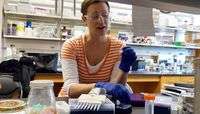Engineering student develops early detection methods for E. coli bacteria

Loreen Lamoureaux, a University of New Mexico biomedical engineering graduate student, is working on ways to quickly detect Escherichia coli or E. coli bacteria in meat before it reaches the consumer. Lamoureaux is one of dozens of collaborators working on a U.S. Department of Agriculture grant to find ways to detect the bacteria as early as possible in the food chain.
Currently, it can take several days to detect bacteria in meat. Lamoureaux and her collaborators are working on a way to make the detection process much faster. Her work at Los Alamos National Laboratory (LANL) with Harshini Mukundan, and at UNM with Professor Steven Graves at the Center for Biomedical Engineering, focuses on ways to detect Shiga toxins and other important markers of the bacteria. She has purified and developed assays for a key biomarker as well as used biophysical methods to characterize the molecular interactions of the biomarkers with cell membranes.
"If we are able to detect E. coli very early on in the beef chair for example, in cows that are in the pasture or in beef samples from the slaughterhouse, we can prevent further contamination down the line, thereby mitigating the effect of mass recalls and illness," Lamoureaux said.
Loreen Lamoureaux, a University of New Mexico biomedical engineering graduate student, is working on ways to quickly detect Escherichia coli or E. coli bacteria in meat before it reaches the consumer. Lamoureaux is one of dozens of collaborators working on a U.S. Department of Agriculture grant to find ways to detect the bacteria as early as possible in the food chain.
Currently, it can take several days to detect bacteria in meat. Lamoureaux and her collaborators are working on a way to make the detection process much faster. Her work at Los Alamos National Laboratory (LANL) with Harshini Mukundan, and at UNM with Professor Steven Graves at the Center for Biomedical Engineering, focuses on ways to detect Shiga toxins and other important markers of the bacteria. She has purified and developed assays for a key biomarker as well as used biophysical methods to characterize the molecular interactions of the biomarkers with cell membranes.
"If we are able to detect E. coli very early on in the beef chair for example, in cows that are in the pasture or in beef samples from the slaughterhouse, we can prevent further contamination down the line, thereby mitigating the effect of mass recalls and illness," Lamoureaux said.
Provided by University of New Mexico
















